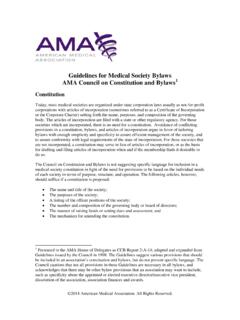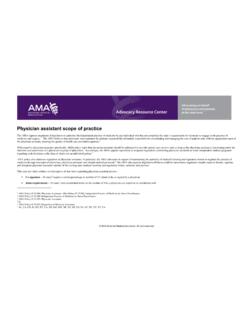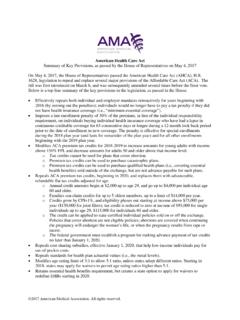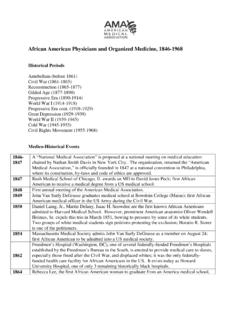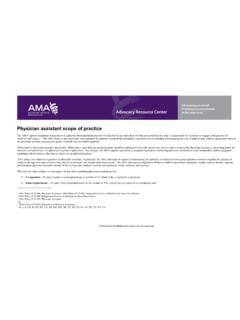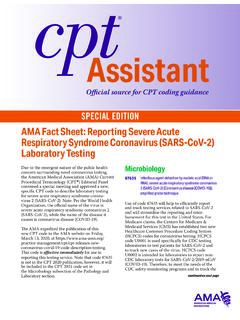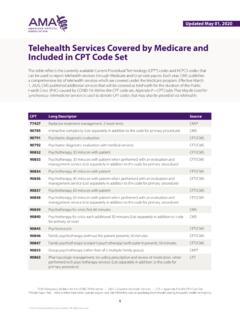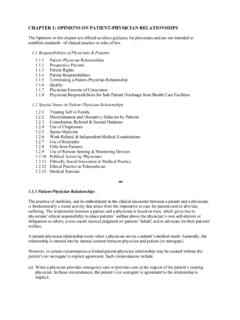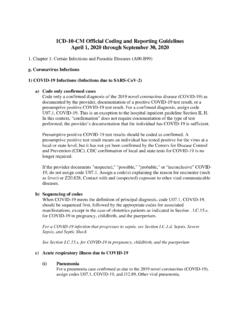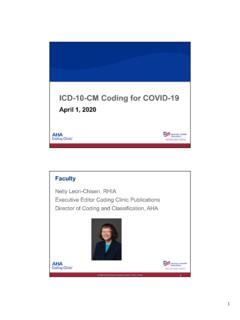Transcription of CPT Assistant guide: Coronavirus (SARS-CoV-2); October 2020
1 Assistant Official source for CPT coding guidance SPECIAL EDITION: October Update COVID-19 October Update As we approach the season for influenza (flu) and studies in the Microbiology subsection in the respiratory syncytial virus (RSV) infections, clini- Pathology and Laboratory section of the CPT code set. cians need to be able to rapidly distinguish these To address the urgent clinical need to report testing, two seasonal infections from infections caused by the Panel expedited the publication of these additional severe acute respiratory syndrome Coronavirus 2 codes to the AMA website on October 6, 2020, at (SARS-CoV-2). Ordinarily, a test panel that evalu- ates these four viruses would be reported using cpt/covid-19- coding -and-guidance. These codes are Current Procedural Terminology (CPT ) code 87631, effective immediately for use in reporting these Infectious agent detection by nucleic acid (DNA or laboratory tests.)
2 RNA); respiratory virus (eg, adenovirus, influenza virus, Coronavirus , metapneumovirus, parainflu- enza virus, respiratory syncytial virus, rhinovirus), Infectious-Agent Detection includes multiplex reverse transcription, when For a list of the new and revised codes specific to performed, and multiplex amplified probe technique, laboratory testing for SARS-CoV-2 and the new and multiple types or subtypes, 3-5 targets. revised parenthetical notes and guidelines to cor- rect and clarify reporting of infectious agent antigen However, as the Coronavirus 2019 (COVID-19) studies, see the following. pandemic continues to progress, the need to be able to distinguish the tests for influenza A, influenza B, and RSV that include SARS-CoV-2 from those Immunology that do not has become apparent.
3 The CPT Editorial Panel (Panel) acknowledged that such codes would 86317 Immunoassay for infectious agent represent a fragmentation of an existing service antibody, quantitative, not otherwise (87631); however, the substantive need created by the specified unique circumstances of the SARS-CoV-2 pandemic provides justification to create specific codes to des- (For immunoassay techniques for ignate such respiratory viral panels. non-infectious agent antigens, see 83516, 83518, 83519, 83520) . The Panel also approved revised guidelines to cor- rect and clarify reporting of infectious agent antigen continued on next page AMERICAN MEDICAL. ASSOCIATION. (For infectious agent antigen A new guideline for correct reporting of infectious detection by immunoassay agent antigen primary source studies using micro- 2 technique, see 87301-87451.)
4 For scopic direct/indirect immunofluorescent assay (IFA). infectious agent antigen detection by techniques vs immunoassay with direct optical (ie, immunoassay technique with direct visual) observation and primary source specimen or optical [ie, visual] observation, see derivative studies using non-microscopic immuno- chemical techniques with fluorescence detection was 87802-87899) . added to the Microbiology subsection. The paren- thetical note following code 86317 was revised with (For particle agglutination the addition of instructions for correct reporting of procedures, use 86403) infectious agent antigen detection by immunoassay technique performed with and without direct optical Microbiology observation. 87250 Virus isolation; inoculation of embryonated eggs, or small animal, Microbiology includes observation and dissection 87301 Infectious agent antigen detection by immunoassay technique, (eg, 87255 including identification by non- enzyme immunoassay [EIA], enzyme- immunologic method, other than linked immunosorbent assay [ELISA], by cytopathic effect (eg, virus fluorescence immunoassay [FIA], specific enzymatic activity) immunochemiluminometric assay [IMCA]) qualitative or semiquantitative.
5 These codes are intended for primary source only. For similar studies on culture material, refer to codes adenovirus enteric types 40/41. 87140-87158. Infectious agents by antigen detection, 87305 Aspergillus immunofluorescence microscopy, or nucleic acid probe techniques should be reported as precisely as possible. 87320 Chlamydia trachomatis The molecular pathology procedures codes (81161, 81200-81408) are not to be used in combination with or 87324 Clostridium difficile toxin(s). instead of the procedures represented by 87471-87801. The most specific code possible should be reported. 87327 Cryptococcus neoformans If there is no specific agent code, the general method- ology code (eg, 87299, 87449, 87797, 87798, 87799, (For Cryptococcus latex agglutination, 87899) should be used.)
6 For identification of antibodies use 86403). to many of the listed infectious agents, see 86602- 86804. When separate results are reported for different 87328 cryptosporidium species or strain of organisms, each result should be coded separately. Use modifier 59 when separate 87329 giardia results are reported for different species or strains that are described by the same code. 87332 cytomegalovirus When identifying infectious agents on primary 87335 Escherichia coli 0157. source specimens (eg, tissue, smear) microscopically by direct/indirect immunofluorescent assay [IFA] (For giardia antigen, use 87329). techniques, see 87260-87300. When identifying infectious agents on primary source specimens or 87336 Entamoeba histolytica dispar derivatives via non-microscopic immunochemical group techniques with fluorescence detection (ie, fluo- rescence immunoassay [FIA]), see 87301-87451, 87337 Entamoeba histolytica group 87802-87899.
7 When identifying infectious agents on primary source specimens using antigen detection by 87338 Helicobacter pylori, stool immunoassay with direct optical (ie, visual) observa- tion, see 87802-87899. 87339 Helicobacter pylori CPT Assistant Special Edition: October Update / Volume 30 2020. (For H. pylori, stool, use 87338. For 87471 Infectious agent detection by nucleic H. pylori, breath and blood by mass acid (DNA or RNA); Bartonella spectrometry, see 83013, 83014. For henselae and Bartonella quintana, 3. H. pylori, liquid scintillation counter, amplified probe technique see 78267, 78268). 87635 severe acute respiratory 87340 hepatitis B surface antigen syndrome Coronavirus 2 (SARS- (HBsAg) CoV-2) ( Coronavirus disease [COVID-19]), amplified probe 87341 hepatitis B surface antigen technique (HBsAg) neutralization 87636 severe acute respiratory 87350 hepatitis Be antigen (HBeAg).
8 Syndrome Coronavirus 2 (SARS- CoV-2) ( Coronavirus disease 87380 hepatitis, delta agent [COVID-19]) and influenza virus 87385 Histoplasma capsulatum types A and B, multiplex amplified probe technique 87389 HIV-1 antigen(s), with HIV-1 and HIV-2 antibodies, single result 87637 severe acute respiratory syndrome Coronavirus 2 (SARS- 87390 HIV-1 CoV-2) ( Coronavirus disease [COVID-19]), influenza virus 87391 HIV-2 types A and B, and respiratory syncytial virus, multiplex 87400 Influenza, A or B, each amplified probe technique 87420 respiratory syncytial virus (For nucleic acid detection of 87425 rotavirus multiple respiratory infectious agents, not including severe acute 87426 severe acute respiratory respiratory syndrome Coronavirus 2. syndrome Coronavirus (eg, [SARS-CoV-2] [ Coronavirus disease SARS-CoV, SARS-CoV-2 {COVID-19}], see 87631, 87632, [COVID-19]) 87633).
9 87427 Shiga-like toxin (For nucleic acid detection of 87430 Streptococcus, group A multiple respiratory infectious agents, including severe acute 87449 not otherwise specified, each respiratory syndrome Coronavirus 2. organism [SARS-CoV-2] [ Coronavirus disease {COVID-19}] in conjunction with (87450 has been deleted. For additional target[s] beyond influenza infectious agent antigen detection virus types A and B and respiratory by immunoassay technique, see syncytial virus, see 87631, 87632, 87301-87451. For infectious agent 87633) . antigen detection by immunoassay technique with direct optical [ie, visual]. 87802 Infectious agent antigen detection by observation, see 87802-87899) . immunoassay with direct optical (ie, 87451 polyvalent for multiple organisms, visual) observation; Streptococcus, each polyvalent antiserum group B.
10 CPT Assistant Special Edition: October Update / Volume 30 2020. 87803 Clostridium difficile toxin A certain terms that are used to describe the method- ologies employed in infectious agent antigen testing, 4 # 87806 HIV-1 antigen(s), with HIV-1 and specifically the concepts surrounding immuno- HIV-2 antibodies fluorescent technique, direct optical observation, and use of single-step versus multiple-step tech- 87804 Influenza niques. See the following discussion on these three concepts. 87806 Code is out of numerical sequence. See 87802-87903. Immunofluorescent Technique 87807 respiratory syncytial virus Immunofluorescence is generally defined as a pro- cedure to detect antigens in cellular contexts using #I87811 severe acute respiratory antibodies and tagged fluorescent markers.
